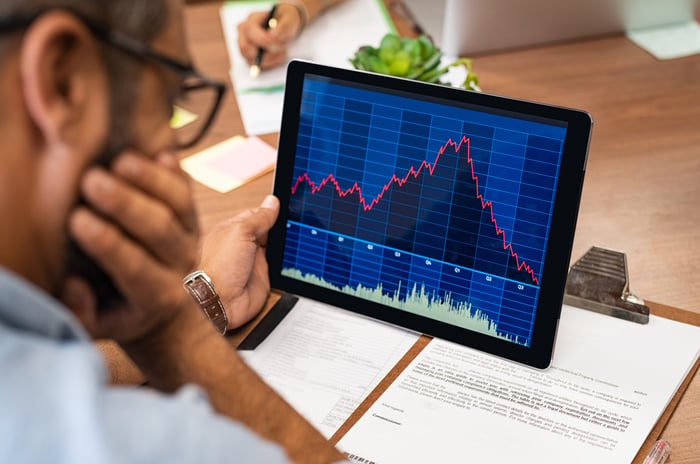Although Nvidia put on a masterclass for Wall Street, history has a long and unblemished track record of big-picture innovations.
Thirty years ago, the trajectory of U.S. and global economic growth was forever changed by the advent of the Internet. While there have been many major trends and highly touted innovations that have attempted to follow in its footsteps, none have come close to matching what the Internet has done for businesses – until now.
The rise of artificial intelligence (AI) is considered by some experts to be the most important advance in innovation since the widespread use of the Internet. When I say “AI,” I’m referring to the use of software and systems for tasks that would normally be overseen or undertaken by humans. Most importantly, these software and systems have the tools to learn and evolve over time without human intervention, opening up endless possibilities in virtually every sector and industry.
How big are the global AI opportunities? Last year, PwC researchers released a report (“PwC Global Artificial Intelligence Study: Harnessing the AI Revolution”) that estimated that AI would add $15.7 trillion to the economy worldwide by the end of the decade. This supernatural figure would result from a combination of increased productivity ($6.6 trillion) and secondary effects on consumption ($9.1 trillion).
Wall Street and investors aren’t going to ignore such massive numbers, which is why the AI heavyweight Nvidia (NVDA 3.55%) has been virtually unstoppable since the start of 2023.

Image source: Getty Images.
On paper, AI titan Nvidia has been impeccable
In just over 17 months, Nvidia stock has gained more than 700% and reached a market value of more than $2.6 trillion. Last week, the company briefly exceeded Apple to become the second largest publicly traded company in the United States, and on Friday, June 7, after the closing bell, Nvidia completed a 10-for-1 forward stock split. This is its second split shares since July 2021.
Although Nvidia has several operating segments, its lightning-fast growth rate has been fueled entirely by the sale of high-powered graphics processing units (GPUs) used in AI-accelerated data centers.
Nvidia’s H100 GPU has become the go-to choice for enterprises wanting to train large language models and run generative AI solutions in their high-compute data centers. According to technology and consulting firm Jon Peddie Research, Nvidia recorded an 88% share of the AI GPU market in the first quarter.
The total domination of the hottest innovations since the Internet became mainstream has its advantages. While demand for the company’s GPUs far outstrips supply – some Wall Street analysts even estimate that the company’s next-generation Blackwell chip will be sold out until 2025 – Nvidia has been able to significantly increase its prices and increase margins. . As of April 28 (the end of Nvidia’s fiscal first quarter), the company’s gross margin stood at an almost unbelievable 78.4%.
Nvidia clearly benefits from its first-mover advantages and the fact that the world’s leading chipmaker Semiconductor manufacturing in Taiwan has increased its chip-on-wafer-on-substrate capacity to allow Nvidia to gradually sell more of its AI accelerator chips.
But even though Nvidia has performed flawlessly on paper, it’s fighting an uphill battle against history, which suggests it will eventually plummet by at least 50%, if not more.

Image source: Getty Images.
Over three decades, the story has also been flawless when it comes to big-picture innovations.
As I mentioned earlier, there has been no shortage of next big trends, technologies and innovations that were supposed to be the best sliced bread. Many of these trends have had one or two leading stocks that rose to the heavens.
The problem is that all of these innovations share a common trend: a bubble bursting event. Professional and everyday investors have a habit of overestimating the adoption and/or usefulness of new technologies. As a result, these fashionable innovations and trends are effectively doomed from the start.
You do not believe me ? Let’s take a trip down memory lane…
- Cisco Systems And Amazon were widely considered the leaders of the dot-com revolution. When the dotcom bubble burst, Cisco and Amazon lost about 90% of their respective value, compared to their pre-dotcom bubble highs. Although the Internet, network infrastructure, and e-commerce have enjoyed enormous success, these innovations have all taken time to mature.
- Genome-decoding companies Celera and Human Genome Sciences emerged in the late 1990s and delivered eye-popping gains to investors with the promise of unlocking the secrets of the human genome at low cost. But, again, the technology was not cheap enough, nor ready for use by the general public. Both companies would eventually fall from their all-time highs before being acquired.
- 3D printing stocks like 3D systems And Stratasys were all the rage from 2011 to 2013, with hopes that 3D printing systems would become a hot item among consumers. Unfortunately, this consumer element did not materialize, resulting in a loss of almost 95% of the value of 3D Systems and Stratasys.
- Blockchain technology was another hot innovation that, in the mid-2010s, was expected to take Wall Street by storm and revolutionize everything from banking to supply chain tracking. But after many years, blockchain still has minimal real-world utility. Since cryptocurrencies and blockchain tend to go hand in hand, Global Coinbaseand the nearly 90% decline it suffered, illustrate another major trend that saw its bubble burst.
- Electric vehicles (EVs) were expected to make internal combustion engine vehicles a thing of the past. Even if the industry leader You’re here is profitable, demand for electric vehicles has declined significantly as consumers have become skeptical of the current charging infrastructure landscape. Tesla shares are down 75% from their peak.
This list is long, but I’ll spare you the entire catalog of industry-leading companies in supposedly can’t-miss innovations that ultimately lost between 50% and 99% of their value.
At no point in the last 30 years has a new megatrend avoided a bubble bursting. While Nvidia is flawless on paper, there is an even longer history of not getting it wrong.
If that wasn’t enough, Nvidia is expected to face a sharp increase in external and internal competition in the current and next calendar year. Both Intel And Advanced microsystems are deploying AI GPUs designed to target Nvidia’s H100 GPU in high-computing data centers. Even if Nvidia’s chips maintain a compute advantage, the mere presence of these competing GPUs will reduce the scarcity that has allowed Nvidia to increase the price of its hardware.
Additionally, Nvidia’s four largest customers, which account for about 40% of its net revenue, develop GPUs in-house for their AI data centers. Even if these chips are only complementary to the H100 GPUs ordered from Nvidia, this likely signals a spike in reliance on Nvidia products.
While it’s impossible to pinpoint a peak, historical data suggests Nvidia is Ultimately will lose more than 50% of its value.
John Mackey, former CEO of Whole Foods Market, an Amazon subsidiary, is a member of The Motley Fool’s board of directors. Sean Williams holds positions at Amazon and Intel. The Motley Fool holds positions and recommends Advanced Micro Devices, Amazon, Apple, Cisco Systems, Coinbase Global, Nvidia, Taiwan Semiconductor Manufacturing, and Tesla. The Motley Fool recommends 3d Systems and Intel and recommends the following options: long January 2025 $45 calls on Intel and short August 2024 $35 calls on Intel. The Motley Fool has a disclosure policy.